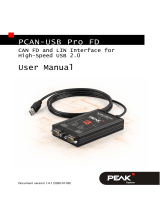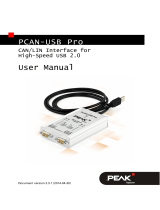Page is loading ...

LIN Interface for USB
User Manual
PLIN-USB
Document version 1.1.0 (2019-03-14)

PLIN-USB – User Manual
2
Relevant products
Product Name Model Part number
PLIN-USB IPEH-004052
PCAN® and PLIN® are registered tradem
arks of PEAK-System Technik GmbH.
Other product names in this document may be the trademarks or registered trade-
marks of their respective companies. They are not explicitly marked by ™ or ®.
© 2019 PEAK-System Technik GmbH
Duplication (copying, printing, or other forms) and the electronic distribution of this
document is only allowed with explicit permission of PEAK-System Technik GmbH.
PEAK-System Technik GmbH reserves the right to change technical data without
prior announcement. The general business conditions and the regulations of the
license agreement apply. All rights are reserved.
PEAK-System Technik GmbH
Otto-Roehm-Strasse 69
64293 Darmstadt
Germany
Phone: +49 (0)6151 8173-20
Fax: +49 (0)6151 8173-29
www.peak-system.com
info@peak-system.com
Doc
ument version 1.1.0 (2019-03-14)

PLIN-USB – User Manual
3
Contents
1 Introduction 4
1.1 Properties at a Glance 4
1.2 Operation Requirements 5
1.3 Scope of Supply 6
2 Installing Software and Hardware 7
2.1 Installing the Device Driver and PLIN-View
Pro 7
2.2 Connecting the PLIN-USB 8
3 Operation 10
3.1 Status LED 10
3.2 Unplugging the USB Connection 10
3.3 Distinguishing Several PLIN-USB 10
4 Software 12
4.1 LIN Monitor PLIN-View Pro for Windows 12
4.1.1 Receive/Transmit Tab 14
4.1.2 Trace Tab 16
4.1.3 Status Bar 17
4.2 PLIN-API for the Connection of Self-created
Programs 18
5 Technical Specifications 20
Appendix A CE Certificate 22
Appendix B Dimension Drawing 23

PLIN-USB – User Manual
4
1 Introduction
The PLIN-USB enables the connection of a Windows computer to a
LIN network via USB. The adapter supports the LIN protocol accor-
ding to the standard ISO 17987 and complies with all LIN specifica-
tions up to version 2.2. The interface can be operated as a master or
a slave.
The monitor software PLIN-View Pro and the PLIN programming
interface for the development of applications with LIN connection
are included in the scope of supply.
1.1 Properties at a Glance
Adapter for High-Speed-USB 2.0 (compatible with USB 1.1 and
USB 3.0)
LIN connection (ISO 17987)
Compliant with all LIN specifications (up to version 2.2)
Bit rates from 1 kbit/s up to 20 kbit/s
Can be used as a LIN master or slave
(1 ms master task resolution)
Automatic bit rate, frame length, and checksum type recognition
Autonomous scheduler with support for unconditional, event,
and sporadic frames
LIN bus connection via D-Sub, 9-pin
LIN connection short-circuit-proof against transceiver supply
and ground
TJA1028T LIN transceiver
Galvanic isolation on the LIN connection up to 500 V

PLIN-USB – User Manual
5
Indicator LED for interface status
Voltage supply via USB
Adapter supply 5 V DC via USB port
Transceiver supply 6 - 28 V DC via D-Sub, pin 9
Extended operating temperature range from -40 to 85 °C
(-40 to 185 °F)
1.2 Operation Requirements
Vacant USB port on the computer (compatible to USB 1.1, 2.0,
and 3.0)
Note: Do not use a USB extension cable for connecting the
PLIN-USB to a computer. The use of an extension cable does
not conform to the USB specification and may cause
malfunction of the PLIN-USB.
Operating system Windows 10, 8.1, 7 (32/64-bit)
Additional DC voltage source 6 to 28 V to supply the
LIN transceiver

PLIN-USB – User Manual
6
1.3 Scope of Supply
PLIN-USB in plastic casing (with 60 cm USB cable)
LIN interface drivers for Windows 10, 8.1, 7 (32/64 bit)
LIN monitor PLIN-View Pro for Windows
Programming interface PLIN-API for developing applications
with LIN connection
Manual in PDF format
Optionally available accessories:
LIN Connection Cable for PC LIN interfaces (IPEK-003013)

PLIN-USB – User Manual
7
2 Installing Software and
Hardware
This chapter covers the software setup for the PLIN-USB adapter
under Windows and the connection of the adapter to a computer.
Install the driver before
you connect the adapter to the computer.
2.1 Installing the Device Driver and PLIN-
View Pro
In order to operate the PLIN-USB on a Windows PC, you must install
the suitable device driver. This is available on the provided Product
DVD. During the installation process, the LIN monitoring software
PLIN-View Pro is installed automatically.
Do the following to install the device driver:
1. Start the Intro.exe software from the supplied Product
DVD.
The navigation program appears.
2. In the main menu, select Drivers and then click on Install
now.
3. Confirm the message from the User Account Control related
to “Installer database of PEAK-Drivers”.
The driver setup starts.
4. Follow the program's instructions. When selecting
components, select the LIN device driver (other components
as needed).
The LIN monitoring software PLIN-View Pro is installed
automatically.

PLIN-USB – User Manual
8
Figure 1: LIN device driver in PEAK-Drivers Setup
2.2 Connecting the PLIN-USB
LIN (D-Sub)
Figure 2: Assignment of the D-Sub connector on the PLIN-USB,
auxiliary supply required for LIN transceiver
In addition to the connection to the LIN bus, the PLIN-USB requires
an external DC power for operation in the range of 6 to 28 Volts.
Apply it to pin 9.

PLIN-USB – User Manual
9
To facilitate the connection, use the optional supply cable with
D-Sub connectors (IPEK-003013).
USB
Connect the PLIN-USB with its USB plug (type A) to a USB port of a
computer or of a USB hub. It does not matter whether the USB port
complies electronically with the standard 1.1, 2.0, or 3.0.
Windows detects the new hardware and initializes the previously
installed device driver. After the successful initialization, the status
LED on the PLIN-USB is lit green (see also section 3.1
Status
LED on
page 10).

PLIN-USB – User Manual
10
3 Operation
3.1 Status LED
For indication of operating conditions the PLIN-USB has an LED on
its top.
LED status Meaning
Green on There's a connection to a driver of the operating system.
Green slow blinking The LIN interface is initialized with a valid bitrate. A
software application is connected to the LIN interface.
Green quick blinking Data is transmitted via the connected LIN bus.
3.2 Unplugging the USB Connection
Under Windows the icon for removing hardware safely is not used
with the PLIN-USB. You can unplug the PLIN-USB from the com-
puter without any preparation.
3.3 Distinguishing Several PLIN-USB
You can operate several PLIN-USB on a single computer at the
same time. To distinguish the interfaces in a software environment,
you need to assign a hardware ID to each interface that is perma-
nently saved in the interface. The hardware ID is independent of the
LIN communication.
Do the following to set the hardware ID in the PLIN-USB:
1. Make sure that the PLIN-USB is connected to the PC and is
initialized (status LED is lit green).

PLIN-USB – User Manual
11
2. Open the Windows Start menu, type peakcpl, and press
the Enter key.
The Properties of PEAK Hardware window opens.
3. Change to the LIN Hardware tab and select the PLIN-USB
interface from the list.
Figure 3: LIN hardware tab in the PEAKCPL software
4. Click on the Set Hardware ID button.
5. Enter a number (either decimal or hexadecimal with suffix
“h”) as the new hardware ID and confirm with OK.
Tip: Add the assigned hardware ID to the casing of the PLIN-
USB, e.g. with a sticker, in order to quickly distinguish similar
interfaces.

PLIN-USB – User Manual
12
4 Software
4.1 LIN Monitor PLIN-View Pro for Windows
PLIN-View Pro for Windows is a display and monitoring program for
LIN messages in connection with PC LIN interfaces from PEAK-
System. The program is part of the device driver installation.
Figure 4: PLIN-View Pro for Windows
Do the following to start and initialize PLIN-View Pro:
1. From the Windows Start menu, select PLIN-View Pro.

PLIN-USB – User Manual
13
The dialog box for selecting the LIN hardware and for
setting the LIN parameters appears.
Figure 5: Connection with the PLIN-USB in PLIN-View Pro
2. From the Hardware list, select the LIN connection to be
used.
3. Determine the operation Mode to be used for the LIN
connection.
4. From the Bit rate list, select the bit rate that is used by all
nodes on the LIN bus.
5. Finally confirm the settings in the dialog box with OK.
The main window of PLIN-View Pro appears.

PLIN-USB – User Manual
14
4.1.1 Receive/Transmit Tab
Figure 6: Receive/Transmit tab
The Receive/Transmit or Receive/Publisher tab is the main element
of PLIN-View Pro. It contains two lists, one for received LIN
messages and one for to be transmitted ones. In Master mode,
Receive/Transmit appears and LIN messages can be transmitted
onto the bus. In Slave mode, Receive/Publisher appears. In this case
it is not possible to transmit messages.
If a Master requests data from a Slave, the Slave can publish the
data within the LIN frame. The Global Frame Table contains all
entries for defined LIN frames that can be used by the LIN interface.
In order to transmit a LIN frame, the basic frame definition in the
properties must be adapted.
Do the following to transmit a LIN frame with PLIN-View Pro:
1. From the Global Frame Table, select a frame.
2. Change the Checksum Type property to Enhanced or
Classic.

PLIN-USB – User Manual
15
3. Change the Direction property to Publisher.
4. Select the menu command Transmit > New Frame.
The New frame dialog box appears.
Figure 7: New frame dialog box
5. From the ID list, select the frame to be transmitted.
6. Enter the Data of the LIN frame in the corresponding field.
7. Confirm the entries with OK.
8. Transmit the selected frame with the menu command
Transmit > Send (alternatively Space bar).
Note: You can also manage and activate schedule tables.
Furthermore, you can open LDF files and use their information
for managing schedule tables, displaying data in symbolic
form, or validate and edit data.

PLIN-USB – User Manual
16
Tip: In order to facilitate the work with the Global Frame table,
the Transmit and Publisher lists and the schedule tables as well
with LDF files, you can put those into a PLIN project file with
the menu item File > Save and reload later on.
4.1.2 Trace Tab
Figure 8: Trace tab
On the Trace tab, the tracer (data logger) of PLIN-View Pro is used
to record and display the communication on a LIN bus.
On startup of the tracer, the Save as dialog box appears. Enter a file
name for saving the recording. The recording is continued until the
LIN tracer is stopped or until the free space on the selected medium
isn't enough anymore.
The upper area of the tab has a bar with information to the tracer
status: the current status of the LIN tracer, the total run time, the
number of recorded LIN frames, and the name of the current trace
file for recording.

PLIN-USB – User Manual
17
4.1.3 Status Bar
Figure 9: Status bar
The status bar shows information about the current LIN hardware,
the connected LIN channel, the mode of operation, the LIN bus
status (Active/Sleep), and a counter for the unsent or unread LIN
frames (Overruns).
You can find further information about the use of PLIN-View Pro in
the help which you can invoke in the program via the Help menu or
with the F1 key.

PLIN-USB – User Manual
18
4.2 PLIN-API for the Connection of Self-
created Programs
Figure 10: PLIN-API
On the provided DVD in the directory branch Develop/PC
interfaces/Windows/PLIN-API are files of the PLIN-API. This
provides basic functions for connecting your own programs to PC
LIN interfaces from PEAK-System and can be used for the following
operating systems:
Windows 10, 8.1, 7 (32/64-Bit)

PLIN-USB – User Manual
19
Furthermore, header files and programming examples (PLIN-View)
are available for creating own applications in conjunction with the
PLIN API for PC-LIN interfaces from PEAK-System. Read the detailed
documentation of the interface (API) in each header file.
Note: You can find further information in the text and help files
(file name extensions .txt and .chm).
Notes about the License
Device drivers, the PLIN interface DLL, and further files needed for
linking are property of the PEAK-System Technik GmbH and may be
used only in connection with a hardware component purchased
from PEAK-System or one of its partners. If a LIN hardware
component of third-party suppliers should be compatible to one of
PEAK-System, then you are not allowed to use or to pass on the
driver software of PEAK-System.
If a third-party supplier develops software based on the PLIN-API
and problems occur during the use of this software, consult the
software provider.

PLIN-USB – User Manual
20
5 Technical Specifications
Power supply
Supply voltage 5 V DC via USB port for PLIN-USB (without
transceiver)
6 - 28 V DC via pin 9 D-Sub for transceiver
(required)
Current consumption USB: 30 mA
Auxiliary supply: max. 20 mA at 12 V
USB
USB mode USB 2.0 Full-speed
USB port Plug type A
Cable length about 60 cm
LIN
LIN standard 2.2, downward-compatible
LIN connection D-Sub, 9-pin, LIN signal on pin 4, galvanic
isolation up to 500 V
Transceiver TJA1028T/3V3/20
Bitrates 1 - 20 kbit/s
Scheduler Initialized by software, processed by hardware
8 schedule tables with 256 slots in all
configurable
Measures
Size 86 x 43 x 21 mm
See also dimension drawing Appendix B on
page 23
Length USB connection cable about 60 cm
Weight about 80 g (incl. cable)
/




